Delicious Persian Pickles Recipe for a Flavorful Snack
Welcome to my kitchen, where I am excited to share with you my favorite recipe for Persian pickles. As a chef, I have always been fascinated by the art of pickling, and the Persian culture has a long and rich history of pickling. These pickles are a staple in Persian cuisine and are known as “torshi makhloot,” which means mixed vegetable pickle.
My recipe is a quick and easy way to make the best Persian pickles right in your own kitchen. These pickles are tangy, flavorful, and have a perfect balance of savory and spicy notes. They are perfect as a side dish, as a condiment, or as a snack.
In this recipe article, I will guide you through every step of the process and give you tips and tricks along the way. Whether you are a seasoned chef or a beginner in the kitchen, this recipe is sure to impress your taste buds and your guests. So let’s get started and make some delicious Persian pickles!
Why You’ll Love This Recipe
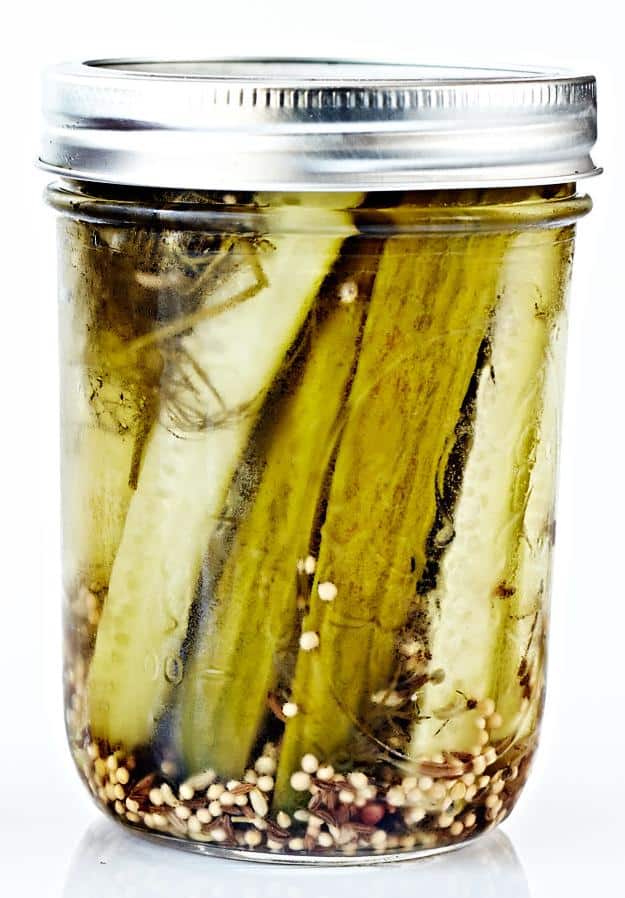
Are you a fan of pickles? If yes, then you’re in for a treat! I’m about to introduce you to my all-time favorite pickle recipe – Persian Pickles. These pickles are a true delight for your taste buds and a great addition to any meal. Here are some reasons why you’ll love this recipe:
Firstly, the ingredients used in this recipe are fresh, healthy, and easily available. You’ll need Persian cucumbers, cauliflower, celery, and a few garlic cloves. The combination of these ingredients creates a unique flavor that you won’t find in any other pickle recipe.
Secondly, this recipe is incredibly easy to follow. All you need to do is mix together vinegar, salt, garlic, and ground ginger in a bowl. Then, chop up your vegetables and mix them into the vinegar mixture. Let the mixture sit in the refrigerator for a few hours and voila, your homemade pickles are ready!
Thirdly, this recipe is extremely versatile. You can make a variety of pickles using this recipe, including pickled eggplant, pickled vegetables, cucumber salad, and even refrigerator pickles. You can also experiment with different spices and herbs to create your own unique flavor.
Lastly, these pickles can be stored for a long time and make a great addition to any meal. They’re perfect for snacking, adding to sandwiches or burgers, or as a side dish to any meal. You can even use them to make a delicious turshi or brine.
In conclusion, if you’re a pickle lover, then this Persian Pickles recipe is a must-try. With its fresh ingredients, easy-to-follow instructions, versatility, and delicious taste, it’s sure to become your new favorite. So, what are you waiting for? Give this recipe a try and experience the best Persian pickles around!
Ingredient List
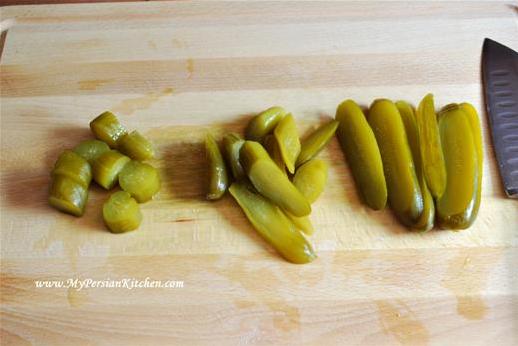
Let’s take a look at the ingredients we’ll need for making Persian Pickles. Don’t worry, most of the ingredients are pantry staples and easy to find in your local grocery store.
Here’s what you’ll need:
- Persian cucumbers: about 1 pound, sliced into rounds or spears
- Cauliflower: 1 head, cut into bite-size florets
- Celery: 2-3 stalks, sliced
- Garlic cloves: 3-4, peeled and minced
- Apple cider vinegar: 1 cup
- White vinegar: 1/4 cup
- Salt: 1 tablespoon
- Sugar: 1 tablespoon
- Ground ginger: 1/2 teaspoon
- Red pepper flakes: 1/2 teaspoon
- Mustard seeds: 2 teaspoons
- Khiar shoor (Persian pickled cucumbers): 1 cup, optional
Note that you can also use regular Kirby cucumbers, but Persian cucumbers are preferred because of their thin skin and crunchy texture. For a quick pickle, you can use Torshi Makhloot (Persian mixed vegetable pickle) instead of making your own.
The Recipe How-To
Here’s how to make the best Persian pickles recipe at home:
Ingredients
- 1 pound Persian cucumbers or Kirby cucumbers
- 1 cup cauliflower florets
- 1 cup celery sticks
- 1 cup sliced red pepper
- 1 cup sliced carrots
- 1 cup sliced onion
- 1 cup apple cider vinegar
- ¼ cup white vinegar
- 2 teaspoons ground ginger
- 2 teaspoons mustard
- 1 tablespoon salt
- 1 tablespoon sugar
- 3 garlic cloves, minced
Instructions
- Wash and slice the cucumbers into ¼ inch thick rounds. If using Kirby cucumbers, cut them into spears.
- In a large bowl, mix together the cucumbers, cauliflower, celery, red pepper, carrots, and onion.
- In a small saucepan, mix together the apple cider vinegar, white vinegar, ground ginger, mustard, salt, sugar, and minced garlic cloves.
- Bring the mixture to a boil over medium heat, stirring occasionally to dissolve the sugar and salt.
- Once the mixture comes to a boil, reduce the heat to low and let it simmer for 5 minutes.
- Pour the hot brine over the mixed vegetables in the large bowl.
- Use a spoon to press down the vegetables and make sure they are fully submerged in the brine.
- Cover the bowl with plastic wrap or a lid and let it cool to room temperature.
- Once cool, transfer the mixture to a large jar or container with a tight-fitting lid.
- Refrigerate for at least 24 hours before serving to allow the flavors to develop.
- Serve cold as a delicious side dish or condiment.
Notes
- To make Persian mixed vegetable pickles, replace the cucumbers with sliced eggplant or other pickled vegetables.
- This recipe can also be used to make a quick pickle or refrigerator pickle by skipping step 6 and transferring the mixture to a jar or container immediately after mixing the brine.
- These pickles will keep in the refrigerator for up to 2 weeks.
Now that you know how to make these delicious Persian pickles, you can enjoy them with a cucumber salad, on sandwiches, or as a flavorful addition to any meal.
Substitutions and Variations

If you’re looking to mix things up with this Persian Pickles recipe, there are plenty of substitutions and variations that you can try out. Here are some ideas to get you started:
– Change up the vegetables: While Persian cucumbers, celery, and cauliflower are the stars of this recipe, you can certainly experiment with other veggies. Try using Kirby cucumbers, pickled eggplant, or other pickled vegetables in place of the Persian cucumbers. You could also add in some sliced carrots, bell peppers, or onions for a different flavor profile.
– Adjust the spice level: If you like things spicy, you can add some red pepper flakes to the brine mixture. Alternatively, you can leave out the ground ginger and use fresh ginger instead for a more subtle heat.
– Sweeten things up: If you prefer your pickles on the sweeter side, you can add a bit of sugar to the brine mixture. Start with 1 tablespoon and adjust to taste.
– Swap the vinegar: While this recipe calls for a mix of apple cider vinegar and white vinegar, you can use all apple cider vinegar or all white vinegar if you prefer. Just keep in mind that this will affect the overall flavor of the pickles.
– Use different herbs and spices: If you’re feeling adventurous, you can experiment with different herbs and spices in the brine mixture. Try adding some fresh dill or thyme, or throw in some whole mustard seeds or coriander seeds for extra flavor.
No matter what substitutions or variations you try, be sure to take notes so you can replicate your favorite versions in the future. Whether you stick to the original recipe or get creative with your own adaptations, these Persian Pickles are sure to be a hit.
Serving and Pairing
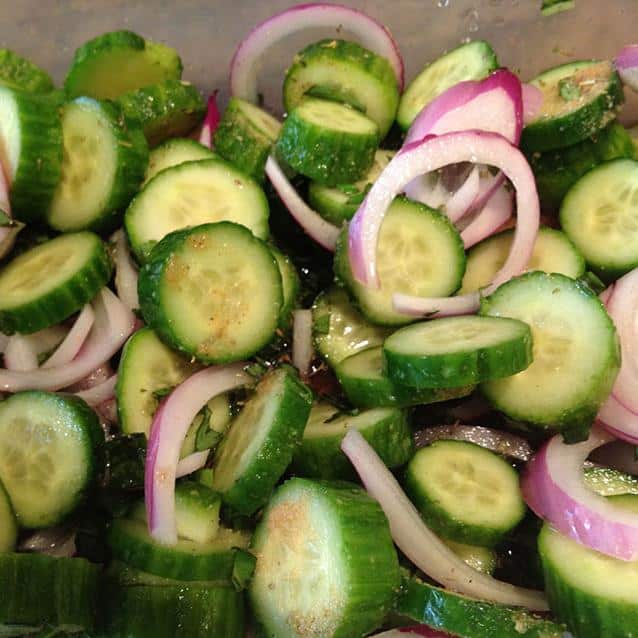
These Persian pickles are a perfect way to add a burst of flavor to any meal. They pair well with grilled meats, sandwiches, and even salads. I love to serve them alongside a bowl of rice topped with a juicy lamb kebab, or with a crispy chicken sandwich for added crunch and tanginess.
For a simple and refreshing side dish, try tossing the pickled vegetables with some fresh herbs, like mint or parsley, and a drizzle of olive oil. This cucumber salad is a staple in Persian cuisine and pairs perfectly with grilled chicken or fish.
If you’re feeling adventurous, try incorporating the pickles into your next charcuterie board. The salty and sour flavors of the pickles complement the richness of the cheese and cured meats, making for a delicious and unique pairing.
These Persian pickles also make a great addition to any sandwich or wrap. The tangy and crunchy vegetables add a bright flavor and texture to any lunchtime dish.
Overall, these pickles are incredibly versatile and can be enjoyed in a variety of ways. Whether you’re looking for a simple side dish or a unique twist on a classic sandwich, these Persian pickles are sure to add a delicious and flavorful element to any meal.
Make-Ahead, Storing and Reheating
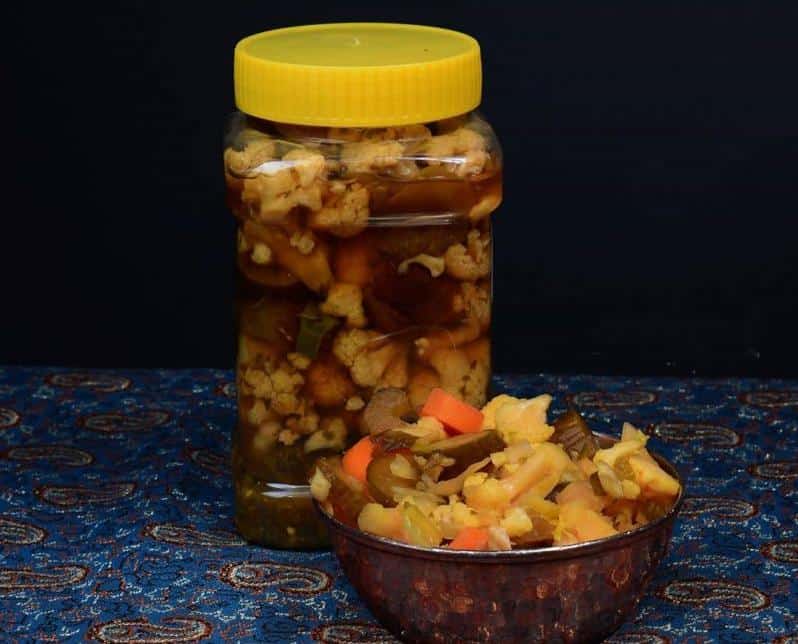
One of the best things about this Persian Pickles recipe is that it is a great make-ahead dish. You can prepare the pickles in advance and store them in the refrigerator for up to a month. This makes them a perfect addition to your meal prep routine, as you can easily add them to salads, sandwiches, or as a side dish.
When storing the pickles, make sure to keep them in an airtight container to prevent them from drying out. The brine will help preserve the pickles, but it is important to keep them covered. You can also store the pickles in a glass jar with a tight-fitting lid.
To reheat the pickles, you can simply let them come to room temperature or microwave them for a few seconds. However, keep in mind that the texture may change slightly after reheating, so it is best to enjoy them cold.
If you have any leftover brine, you can use it to pickle other vegetables, such as eggplant or carrots. This will give you a variety of pickled vegetables to enjoy throughout the week.
Overall, the make-ahead and storing options for this Persian Pickles recipe make it a convenient and delicious addition to any meal. Just be sure to store them properly to maintain their freshness and flavor.
Tips for Perfect Results
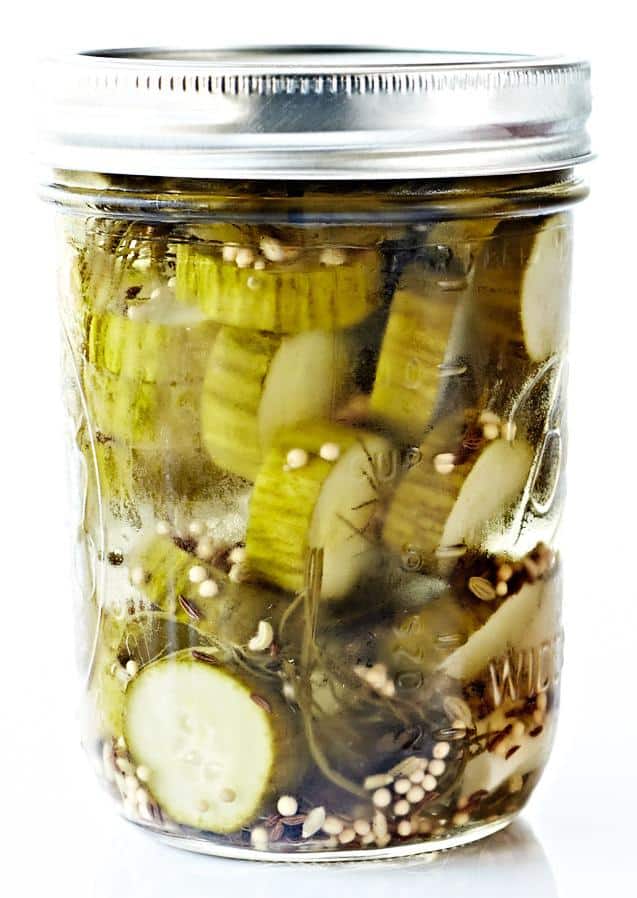
Here are some tips to ensure that your Persian pickles turn out perfectly:
1. Use fresh vegetables: Make sure to use fresh and ripe vegetables for the pickling process. This will ensure that the pickles have a good texture and flavor.
2. Cut the vegetables evenly: Cut the vegetables into even pieces to ensure that they pickle evenly. This will also help to ensure that the pickles have a uniform texture and flavor.
3. Use the right vinegar: Use apple cider vinegar or white vinegar for the pickling solution. These types of vinegar have the right acidity level to preserve the vegetables and give them a tangy flavor.
4. Add the right spices: For the best Persian pickles, add ground ginger, red pepper, and garlic cloves to the pickling solution. These spices add a depth of flavor to the pickles and make them more interesting.
5. Don’t overdo the salt: Use salt sparingly in the pickling solution. Too much salt can overpower the flavors of the vegetables and make the pickles too salty.
6. Let the pickles marinate: After the vegetables have been pickled, let them marinate for at least a few days before eating them. This will give the flavors time to develop and will result in a more flavorful pickle.
7. Experiment with different vegetables: While Persian pickles are traditionally made with cucumbers, you can also try pickling other vegetables like cauliflower, celery, and eggplant. This can add variety to your pickling repertoire and result in some delicious new flavors.
By following these tips, you’ll be able to make the best Persian pickles possible. Experiment with different spices and vegetables to find your perfect combination.
FAQ
Before we wrap up this Persian Pickles Recipe article, I want to address some frequently asked questions about this recipe. I hope this section will help you troubleshoot any issues and answer any lingering questions you may have. So, let’s dive in!
Are Persian cucumbers good for pickles?
When it comes to pickling cucumbers, there are a few options to consider. Kirby cucumbers, known for their bumpy skin and small size, are commonly used. However, my personal preference is for Persian cucumbers, which have a thinner skin and are also on the smaller side. In the event that those are not available, English cucumbers can also be used as long as they have a thin, non-waxy skin.
Why are Persian cucumbers better?
When compared to regular cucumbers, these particular ones have a slender shape and a refreshing crunch. Their flavor is subtle and not overpowering, and they tend to retain less water than other varieties.
Are Persian cucumbers the same as pickling?
When it comes to cucumbers, not all varieties are created equal. While Persian cucumbers are known for being burpless and versatile enough for slicing and pickling, other types have their own specific uses. For example, Kirby cucumbers are best for pickling and don’t fare well when sliced. On the other hand, American slicing cucumbers are not ideal for pickling and are better suited for salads or sandwiches. Knowing the characteristics of different cucumber types can help you choose the right one for your recipe.
What is Torshi in Persian?
Pickled vegetables, known as torshi in Persian, are a staple in Iranian cuisine and are considered an essential part of any meal.
Bottom Line
In conclusion, if you are a pickle lover or just looking for a new way to spice up your dishes, I highly recommend giving this Persian Pickles recipe a try. With its unique blend of spices, tangy vinegar, and crisp vegetables, it’s sure to become a new favorite in your household. Plus, it’s easy to make and can be stored for months, making it a great addition to your meal prep routine.
Whether you’re enjoying them on their own, using them to add a pop of flavor to a sandwich, or even incorporating them into a salad, these Persian Pickles are versatile and delicious. So why not take a chance and add some new flavors to your kitchen? I promise you won’t be disappointed.
Persian Pickles Recipe
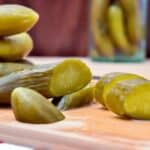
From a recipe at World Hearth, author unknown.
- 1 cup cauliflower, blanched
- 1 cup carrot sticks, blanched
- 1 cup celery, sliced
- 1 1/2 cups apple cider vinegar
- 2 garlic cloves, minced
- 2 1/2 teaspoons salt
- 1 dash ground ginger
- Soak vegetables in water overnight, then drain.
- Mix together vinegar, salt, garlic & ginger in a 2-quart jar.
- Add vegetables, then pour in vinegar.
- Cover and marinate 3 days in refrigerator.
[custom-related-posts title=”Recommended Recipes Just For You” none_text=”None found” order_by=”date” order=”ASC”]
